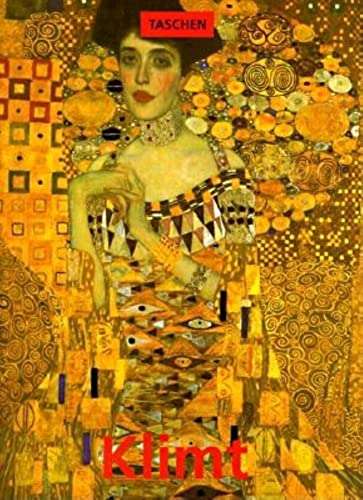Published by Taschen, 1996, softcover, illustrated, 96 pages, 23.3 cms x 30.1 cms, condition: as new.
Gustav Klimt (1862-1918) is one of the most popular artists of the late 19th- and early 20th-centuries. A founding member of the Viennese Secession and a leader of the Art Nouveau movement, Klimt was an innovator who achieved success with large decorative schemes as well as smaller portraits and paintings. He is admired for his sensuous images of women and for his original vision, producing images such as "Love", "The Three Ages of Man" and "The Kiss".
Gustav Klimt (1862-1918) was an Austrian symbolist painter and leader of the Vienna Secession Movement - a group of artists who left the painting academy and joined Symbolism.
Gustav Klimt (1862-1918) was born in the small town of Baumgarten, south of Vienna, in Imperial Austria, which in 1867 was replaced by the Austro-Hungarian Empire. Son of Ernest Klimt and Anna Finster, he was the second of the couple's seven children. At 14, he entered the Vienna School of Arts and Crafts with his brother Ernest. Soon the two were drawing and selling portraits from photographs.
In 1879, Gustav, his brother, and his friend Franz Matsch began to assist their teacher in painting murals for the Vienna Museum of Art History atrium. In 1980 they started to receive orders and carried out various works, among them four allegories for the roof of the Sturany Palace in Vienna, the top of the Karlsbad thermal bath building in Czechoslovakia, and the decoration of Villa Hermès based on drawings by Hans Makat.
In 1886, Gustav's style began to differ when carrying out work for the Burgtheater in Vienna, moving away from the academism of conventional painting learned at school. In 1890, Gustav Klimt founded and chaired, together with other artists, the "Austrian Association of Figurative Artists," intending to oppose the conservative Society of Viennese Artists.
Engaged in a new perspective, he developed a highly decorative production, gaining excellent visibility and being asked to decorate buildings and institutions, such as the decoration of the ceiling and side staircases of the imposing "Municipal Theater of Viena," in addition to having completed the decoration project of the "Historical Museum of Art."
In 1894, he was given the task of painting three large panels for the ceiling of the auditorium of the University of Vienna to represent the figures of Philosophy, Medicine, and Jurisprudence. In 1900, he presented his first panel but left aside the style that had enshrined it. He used unusual allegories in which naked female bodies were shown in obscene poses, which was the target of criticism and heated controversy. The last panel was only completed in 1907. That same year, he led a group of artists who founded the "Vienna Secession" and adhered to symbolism - the Austrian version of decorative Art Nouveau.
His most famous works belong to the "golden phase," in which he uses gold leaves and mainly portrays women adorned by small objects and geometric shapes, as in "Portrait of Adele Bloch-Bauer" (1907) and "The Kiss" (1907-1908 ), his masterpiece. He painted with extreme detail, taking his models to very long sections. He was in love with Emílie Flöge, with whom he had a long love affair and was his companion for years.

